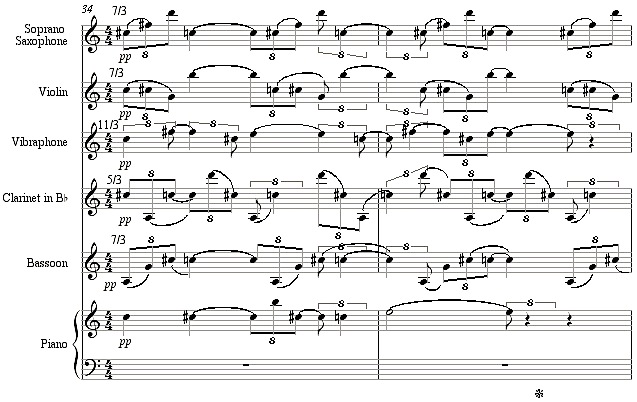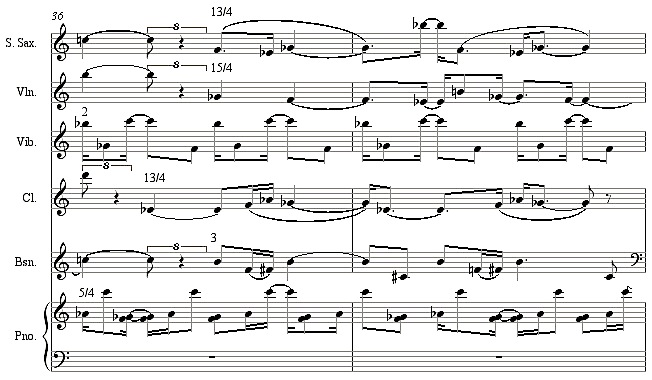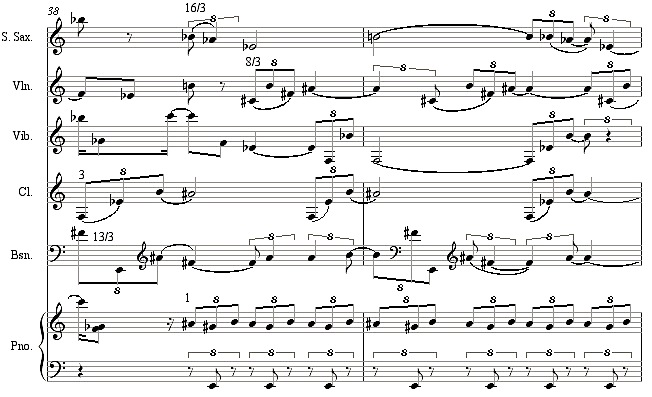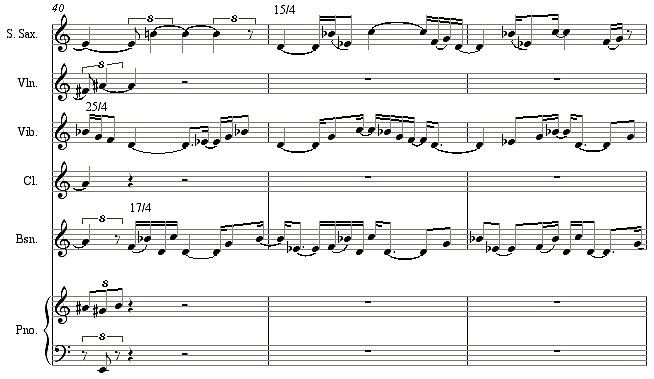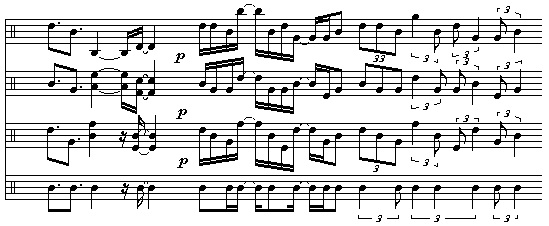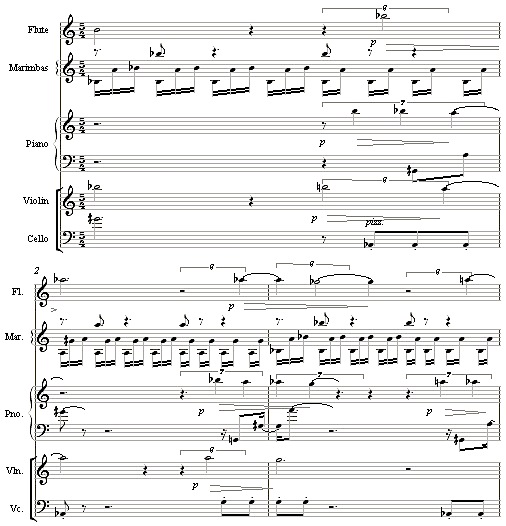I spoke in my last post of James Tenney's postminimalist streak, which I have always most associated with his Tableaux Vivants of 1990. A few years ago, learning of my intense interest in the piece, Jim kindly sent me a score, and I've long itched to analyze it, never finding the time until this week. As I start working my way through it, I realize that it is far more complex than it sounds on the recording by the Toronto ensemble Sound Pressure, and that it is really not postminimalist at all, but rather classically totalist, or, as we now call it here, metametric. It is unusual for Tenney in being composed mostly of repeated phrases, and in that those phrases loop at different lengths to create a counterpoint of recurring impulses at different speeds (or rather a "harmony of phrase lengths," as Cowell would have said). The piece sounds gently undulating, not as wild as it looks, because of its uniformly soft dynamic level. May Doug McLennan and those with dial-up modems forgive me, but I'm going to post several measures of this 20-minute work here. All I've added, in numbers above each new phrase, is the length of the phrase expressed in beats (i.e., 11/3 = 11/3 of a quarter-note long, or 3 and 2/3 beats):
As you can see, or figure out anyway:
the first "moment" in mm. 34-35 forms lines in triplet 8th-notes, to make repeating periodicities of 5 against 7 against 11;mm. 36-37 move to a 16th-note common unit for phrase/phase relationships of 5 against 12 against 13 against 15 (12 being the clarinet line three beats long);
m. 38 changes back to triplets for loops of 3 (piano) against 8 (violin) against 9 (clarinet) against 13 (bassoon) against 16 (sax);
and in mm. 40-42, a trio pursues phrase loops of 15 against 17 against 25 in 16th-notes. Notice that this last passage is entirely within the B-flat major scale.
I've posted Sound Pressure's recording of the piece here. The excerpt given above begins at 2:18, immediately following the first sustained vibe-and-piano chord.
In his program notes, Jim calls the piece an attempt "to resume the exploration of harmony in the twentieth century without regressing to some earlier style...." He alludes to stochastic processes, by which I imagine he means the way the pitches are chosen, which seems somewhat random from "moment" to "moment": the instruments overlap in pitch considerably (which puts the bassoon, you'll notice, in an incredibly high register even above Le Sacre du Printemps), and the harmonies range from quite tonal to sharply dissonant. I take this to mean that the harmonic aspect of the piece is not susceptible to conventional analysis; if anyone knows more about the piece in this (or any other) respect, I'd appreciate some sharing of information.
What surprises me most is the use of repeated motives in lengths not divisible by the quarter-note beat to create an effect of conflicting periodicities not based on the beat, and also a kind of gear-shifting effect, as those periodicities switch among lengths like 13/3, 3, and 15/4, quite akin to what totalists like Michael Gordon, Mikel Rouse, and myself were doing in the '80s and '90s. Compare it, for instance to this gear-shifting effect, also using "misaccented" triplets to change the perceived pulse, from my Snake Dance No. 2 (1994) for unpitched percussion:
Then with this passage from my Unquiet Night (2004) for Disklavier, which combines periodicities of 21/13 of a measure (top system), 16/11 of a measure, and 13/7 of a measure:
Then look at this passage near the end of Bunita Marcus's chromatically saturated Adam and Eve (1987), with its implied periodicities slightly longer than a measure in the piano, violin, and flute, and an impression of layered tempos created by both triplets and septuplets:
It so happens I still have Adam and Eve on my web site, so you can hear it here; the excerpt above comes late in the piece.
Next here's an excerpt from Michael Gordon's Yo Shakespeare (1993 - mp3 on my web site here). The little threes above the top system indicate triplet quarter notes, even though other notes are interpolated between them; the grouping of triplets in quantities indivisible by three was a potential Henry Cowell pointed to in New Musical Resources, which I also tried out in my Folk Dance for Henry Cowell (1997). I don't even know what instruments these are in Michael's score, because my old copy was pre-publication, but each line is doubled. The top system gives a repeating rhythm 7/3 beats long in quarter notes, the middle line has a rhythmic pattern 7 16th-notes long (7/4 of a beat), and the bottom repeating phrase is five beats long:
And we can even find the same basic idea in easier, more orchestrally digestible form in John Adams's Lollapalooza (1995), one of his most totalist works. Here a three-beat ostinato in the bass clarinet marks a steady tempo against which the other instruments repeat ornamental phrases at various periodicities, including the title "Lollapalooza" motive every five beats in the triombones and tuba (score greatly simplified and much material omitted):
I'd like to think that Adams was inspired to play with loops-out-of-phase by listening to the younger generation, but he could well have absorbed the same technique from Nancarrow, whose music he has championed, and whose Studies Nos. 3, 5, and 9 in particular experiment with a similar device. [UPDATE: Actually, he had already used similar structures as early as Shaker Loops.] Another example could be John Luther Adams's Dream in White on White (1992), which carries out the idea at lengths too great to quote in notation here. Even I've got limits.
In any case, I was pleasantly surprised to find Tenney playing around with the same metametric concerns as me and my totalist crowd. Any info about Tableaux Vivants would be much appreciated. Perhaps he even has other similar pieces, I'm certainly not familiar with his entire output. The examples above will be raw material not only for my Music After Minimalism book, but for a paper I'm presenting ("Phase-Shifting as an American Compositional Temptation") in September at a minimlism conference at the University of Bangor in Wales.
COMMENTS:
Kyle Gann says: May 31, 2007 at 4:12 pm - [Chirping of crickets; in the distance, the wail of a coyote is heard.]
Joseph Pehrson says: May 31, 2007 at 10:05 pm - Well, the most intriguing aspect of these most recent articles, for me, is that the music can actually be *heard.* I don't know how that is going to be done at time of publication (a CD, a web link?) or perhaps a web reprint, but it really does bring this important study to life... for me anyway.
andrea says: June 1, 2007 at 10:00 am - yeah kyle, we can't exclaim "i'm learning! i'm learning!" every time you post. sheesh. =P honestly, these kinds of posts are my favorite thing about your blog. if i don't comment, it's because i've been stunned into meditative silence. (hmm... you'll never believe that, will you?)
KG replies: Oh, Andrea, you always make me lol. I always brace for dissent; normally, the word "totalism" alone is enough to spur a torrent of at least skepticism, if not abuse. And I was hoping some Tenney aficionado would write to tell me what I'm missing with Tableaux Vivants. I'm kicking myself for not having analyzed it while Jim was around to answer questions.Galen H. Brown says: June 1, 2007 at 9:00 pm - Okay, Kyle, here's some token skepticism for you: If Kyle Gann, foremost chronicler of the rise of totalism, listens to a piece and isn't able to tell "that it is really not postminimalist at all, but rather classically totalist" until he studies the score, is it really totalist? What's the point of having a name for a genre if you can't tell by listening to a piece which genre it falls into? Isn't genre categorization about grouping pieces into groups based on how they sound, not how they're constructed? I'm not actually challenging the existence of "totalism" or "metametrics" or "brain-hurty-minimalism" or whatever we want to call it. In a piece like Michael Gordon's "Trance," for instance, it's very clear that part of the point is that there are a bunch of different things going on that are regular, but that they don't fit together in the neat way we're accustomed to, and yet the combined effect still works. Part of the fun of listening to the piece is mentally switching around from meter to meter. So what do you do with a piece that looks Totalist on paper but doesn't actually produce the aesthetic effect that Totalism produces? "It's somewhere inbetween" is probably a perfectly fair answer, but I'm not sure. I'm reminded of a great Neil Gaiman line from _The Day I Swapped My Dad for Two Goldfish_. In it, the brother threatens the sister that if she doesn't do what he wants he'll "tell Mom you're secretly fat." Can a piece be secretly Totalist? And for the token abuse: your mother dresses you funny.
KG replies: "Isn't genre categorization about grouping pieces into groups based on how they sound, not how they're constructed?" Good lord, whoever said that? Who does musicology based on how pieces sound? If that happened, wouldn't Arvo Part suddenly be a Renaissance composer? Now that I've realized how Tableaux Vivants works, I hear it very differently, and, in fact, much more accurately. Part of the way I heard it before was based on facile misperceptions that my analysis of it has helped clear away. Hopefully, my talking about it will help people fit it more appropriately into the musical discourse. And as an erstwhile music critic, I am the last person on earth to entertain an argument that the way a piece of music is talked about shouldn't influence the way it sounds. I think far too much emphasis is put on the hypothetical, tabula rasa, out-of-context perceptual experience that doesn't really exist. Or to misquote Charles Ives, "My god, what has sound got to do with musicology?"Joseph Pehrson says: June 2, 2007 at 4:31 pm - Well, this Tenney piece certainly doesn't repeat in the kind of obvious way that would lend one to immediately term it a "minimal"-type work ("normal" or "post"). However, is it not true that La Monte Young, and certain other rather "static-sounding" works are referred to as "minimalist" in some circles? So, therefore, perhaps the Tenney is just a particular branch of "minimalism"??
Galen H. Brown says: June 4, 2007 at 11:56 am - Yeah, clearly what I was proposing doesn't really hold up under much scrutiny - I warned you it was "token skepticism" Serialism has a similar situation - we draw a distinction between serialist modernism and non-serialist modernism, but clearly most people can't hear the row going by. I like the story of how Henry Brandt apparently had an ongoing challenge that he'd be willing to be somebody money that he could write a serialist piece and a non-serialist piece at the person taking the bet wouldn't be able to tell which one was serialist when he listened to it - apparently nobody ever took him up on his offer. I do think you go a little bit too far in saying "who does musicology based on how pieces sound," but it may be that you overstated your position because you were provoked. The fact that Part "sounds" a lot like a Rennaisance composer is pretty important to the aesthetic that he's cultivating. Your point about the mythical tabula rasa listening experience is pretty important, and having it stated so concisely was alone worth having provoked you. But in addition to knowledge of the internal structure of the piece, our knowledge about the way other pieces sound, and how this piece compares sonically to how other pieces and things sound, is crucial to the non-tabula-rasa experience. I think sonic inertextuality is an integral part of good musicology. Without knowing Palestrina we can't really understand Part; without knowing the sound of the machine age we can't really understand Ballet Mechanique. The fact that after analyzing the piece you can now hear it as a Totalist piece actually reinforces the idea that the way a piece sounds is important to genre grouping, but you remain correct that even if you still heard it the same way it would still be reasonable to relabel it as Totalist–the way something sounds isn't the _only_ consideration for genre grouping.
ciarán maher says: January 8, 2008 at 3:39 pm - hey kyle
i hope you remember me – we met at dartington in devon where i was a student of bob gilmore's studying jim's theory and music.
anyway, it may be only a little relevant here, but i thought you'd like to know i recently generated new tenney pieces spectral variations for player piano (from spectral canon for conlon nancarrow). they're really very beautiful.
you can hear the tests and read a little blurb here: http://www.rhizomecowboy.com/spectral_variations/
ciarán
KG replies: Hi Ciarán, nice to hear from you. I'll take a listen.
Copyright 2011 by Kyle Gann
Return to the PostClassic Blog Archive
Return to the Kyle Gann Home Page
